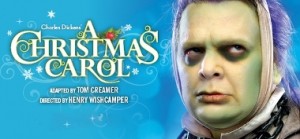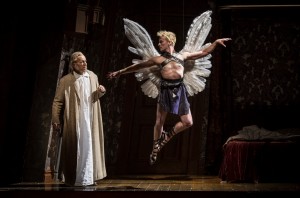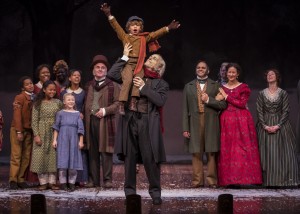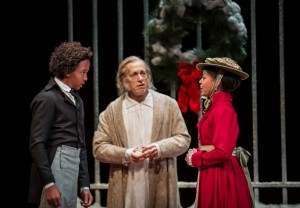
 Highly Recommended ***** For many of us (including myself), Charles Dicken’s “A Christmas Carol” is the first show we saw as children, and almost all of us have seen or read it in some form or another many times since so that we often know, even word for word, what is coming. Scrooge (Larry Yando) is a miserly money-lender who scoffs at Christmas with its emphasis on charity, family, and fellowship. The ghost of his partner Marley (Joe Foust), who has spent the years since his own death wandering the earth, witnessing the love he might have shared but didn’t because of his own avarice, comes back to haunt Scrooge, and tells him that his only hope of escaping the same fate is to be haunted by three ghosts: those of Christmas Past, Present, and Future. The first Ghost, that of Christmas Past (Patrick Andrews), forces Scrooge to bear witness to the traumas of his early life and his descent into greed, and eventually, pain and bitterness. Next, The Ghost of Christmas Present (Lisa Gaye Dixon) reveals to Scrooge the agony he is causing the Cratchit’s family, and leads him to the realization that he is tied by obligation to his clerk, Bob Cratchit, in ways that goes far beyond providing a wage based on what “the market will allow.” Finally, the Ghost of Christmas Future shows him what will happen to his own life and to the lives of the around him if the shadows of those things that are yet to come remain unaltered by the present.
Highly Recommended ***** For many of us (including myself), Charles Dicken’s “A Christmas Carol” is the first show we saw as children, and almost all of us have seen or read it in some form or another many times since so that we often know, even word for word, what is coming. Scrooge (Larry Yando) is a miserly money-lender who scoffs at Christmas with its emphasis on charity, family, and fellowship. The ghost of his partner Marley (Joe Foust), who has spent the years since his own death wandering the earth, witnessing the love he might have shared but didn’t because of his own avarice, comes back to haunt Scrooge, and tells him that his only hope of escaping the same fate is to be haunted by three ghosts: those of Christmas Past, Present, and Future. The first Ghost, that of Christmas Past (Patrick Andrews), forces Scrooge to bear witness to the traumas of his early life and his descent into greed, and eventually, pain and bitterness. Next, The Ghost of Christmas Present (Lisa Gaye Dixon) reveals to Scrooge the agony he is causing the Cratchit’s family, and leads him to the realization that he is tied by obligation to his clerk, Bob Cratchit, in ways that goes far beyond providing a wage based on what “the market will allow.” Finally, the Ghost of Christmas Future shows him what will happen to his own life and to the lives of the around him if the shadows of those things that are yet to come remain unaltered by the present.
I took a class at Loyola University in which Professor Micael Clarke wisely assigned “Christmas Carol” as an example of secularism in the Victorian Novel for Scrooge’s redemption is secular well as spiritual. As I see it, the damnation of which Marley warns emphasizes not the separation from God’s eternal love, but the torment of the separation from that earthly love which Marley might have shared in life with other men and women: his “fellow passengers to the grave,” but didn’t. Likewise, Scrooge is redeemed by a trinity that is as much temporal (concerning time) as it is spiritual—although the Ghost of Christmas Present makes clear that she dates the beginning of her family from Christ’s birth. Perhaps it is Dickens anticipation of a celebration and understanding of Christmas that is more secular, even among the very religious, that makes it arguably the most recognizable and consumed of all Christmas stories outside The Nativity. 
Faced with this challenge of hyper-familiarity, The Goodman Theater’s production uses dazzling effects (Andrea Gentry, Madeleine Borg); lighting (Keith Parham); sound (Richard Wooodbury); creative, often period, costumes (Heidi Sue McMath); and a gorgeous array of sets (Todd Rosenthal) to surprise, and to defamiliarize the story. Partially through the help of a narrator (Kareem Bandealy), Tom Creamer’s script preserves some of the peculiarities of language and humor unique to Dickens which are at once strange and familiar: “ [Scrooge was] as solitary and self-contained as an oyster.” While this production’s general ambience is one of nostalgia and warmth, Creamer does not neglect the darkest parts of the story, or the Victorian world, and includes the starving pauper children who “ignorance and want” who the Ghost the of Christmas Present tell Scrooge belong to mankind, the criminal underworld, and the social injustice created by The Poor Law’s and threatened by Sabbatarianism (I think the latter requires more cultural knowledge than even the most sophisticated theater goer is likely to have—my spell check certainly doesn’t recognize it, but it may have been impossible for Creamer to resist the Ghost of Christmas Present’s retort, “here are some upon this earth of yours, there are those who lay claim to know [me and my brethren], and who do their deeds of passion, pride, ill-will, hatred, envy, bigotry, and selfishness in our name, who are as strange to us and all out kith and kin, as if they had never lived.”
I’ve always felt as if The Goodman is awfully cavalier about color-blinding this show, and I have seen it fall down under the utter implausibility of so many ethnicities linked by kinship in Victorian London. In this season’s production, however, it was remarkably successful—despite the child and adult Scrooge being played by actors of different ethnicities. Under Henry Wishcamper’s direction, Larry Yando gives a performance as Scrooge which more than captures the larger than life miser turned joyful, avuncular, and slightly deranged repented sinner that lives our shared cultural consciousness while William A. Burke is extremely interesting as the boy Scrooge, conveying a sense of vulnerability and frailty which helps us begin to make sense of the man that we initially saw as a “covetous, old, sinner.” Lisa Gaye Dixon has a suitably booming presence and charisma as the Ghost of Christmas Present. She is warm and wise, and captures a spiritual otherness: becoming an invisible ambassador of peace, goodwill, and charity towards all who share Christmas in love, especially (as she notes), the poor who need her most. Ultimately, this production succeeds with an excellence mix of warmth and darkness, nostalgia and relevance, dazzlingly effects and powerful acting, so that the story is represented in a rich but familiar way that will fill audiences with warmth, and introduce younger people to this beloved Christmas story.
“A Christmas Carol” runs at The Goodman Theater, which is located at 170 N. Dearborn Street in downtown Chicago, through December 28. There are frequent performances throughout the week sometimes twice a day, but show times vary greatly. Tickets are between $31 and $101 with discounted tickets available for Students and military families. They can be purchased at www.goodmantheater.org by calling 312-443-3800. The show runs for two hours and twenty minutes with one intermission.
To see what others are saying, visit www.theatreinchicago.com, go to Review Round-up and click at “A Christmas Carol”







More Stories
“The Firebugs” reviewed by Julia W. Rath
“The Book of Grace” Al Bresloff with another from Paul LIsnek
“The Last Five Years” MILWAUKEE